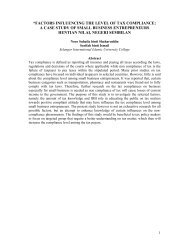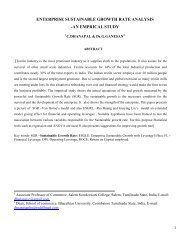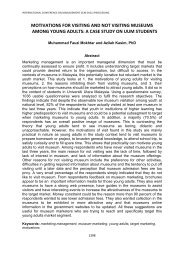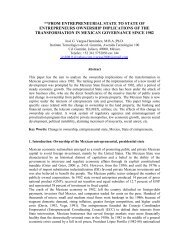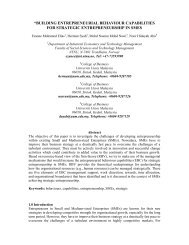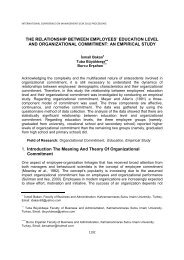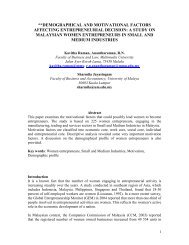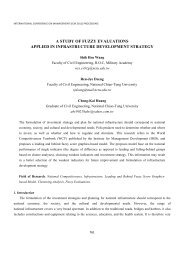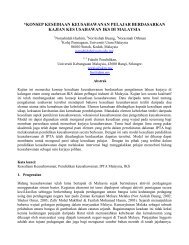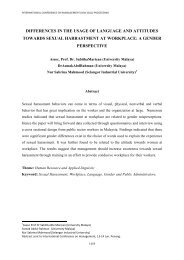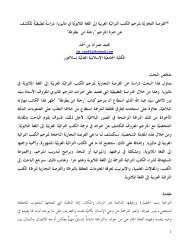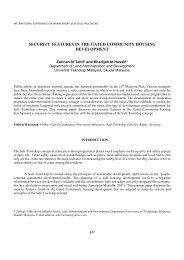operational analysis of a select spinning mill - International ...
operational analysis of a select spinning mill - International ...
operational analysis of a select spinning mill - International ...
You also want an ePaper? Increase the reach of your titles
YUMPU automatically turns print PDFs into web optimized ePapers that Google loves.
Douglas Production Function assess the effects <strong>of</strong> various inputs like raw material, labour store<br />
cost, power, interest, depreciation and other costs involved in the production <strong>of</strong> yarn. The log<br />
linear form <strong>of</strong> production function used is based on the following equation.<br />
LnY =α+β1LnX1+ β2LnX2 + β3LnX3+ β4LnX4 + β5LnX5 + β6LnX6 + β7 LnX7 +uµ<br />
Where,<br />
Ln Y = Dependent Variable –Spinning production per Spindle shift.<br />
X1= Xn are independent variables;<br />
X1 = Raw Material cost /Spindle shift; X2 = Salaries and Wages/spindle shift<br />
X3= Stores cost / Spindle shift; X4 = Power cost / Spindle shift<br />
X5 = Other costs/ spindle shift; X6 = Interest cost/ spindle shift<br />
X7 = Depreciation cost/ spindle shift<br />
α = constant /Intercept.<br />
β = co-efficient;<br />
u =Random disturbance term;<br />
Ln = Natural Logarithms.<br />
To predict the production, first <strong>of</strong> all the dependent and independent variables are to be<br />
fixed in the production function equation and processed to get constants and co efficient. To<br />
arrive this following steps are carried out.<br />
In the first step data related to the production function as given in the following tables<br />
have been applied in the multiple regression models after converting the same in its log form to<br />
arrive the constants and coefficients. In the second step the resultant constants and coefficients<br />
are applied in the Cobb Douglas production function to estimate the production. In the third step<br />
the ten year averages <strong>of</strong> independent variables <strong>of</strong> all the four companies have been calculated. In<br />
the fourth step such average cost is applied in the production function along with the constants<br />
and co-efficient to predict the production <strong>of</strong> each company to evaluate the production<br />
achievement <strong>of</strong> the companies. The following table shows the unit wise constants and<br />
coefficients variables related to the production function.<br />
Table 8.<br />
Constants and Coefficients –SSM Ltd Unit-1 and Unit-2<br />
COMPANY SSM-UNIT-1 SSM-UNIT-2<br />
CONSTANTS 3.66 3.92<br />
CO-EFFICIENTS<br />
Mat. cost /sple sft 0.21 0.72<br />
S& Wages/sple sft -0.06 0.29<br />
Stores/Sple Sft -0.08 0.36<br />
Power/Sple Sft 0.77 -0.83<br />
Other costs/Sple Sft -0.51 1.77<br />
Interest/Sple Sft -0.29 -0.5<br />
Dep/Sple Sft 0.01 0.93<br />
The regression equation for SSM LTD UNIT-1 is given below:<br />
Ssm-1.pdnpersplesft = 3.6585 + 0.206866*ssm-1.rawpersft - 0.0619988*ssm-<br />
1.swpersplesft - 0.0816154*ssm-1.storpersplesft + 0.773897*ssm-1.powerpersplesft -<br />
0.510007*ssm-1.otherpersplesft - 0.287602*ssm-1.intpersplesft + 0.0112882*ssm-<br />
1.deppersplesft.<br />
9




